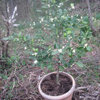Please help identify cause of yellowing leaves on kumquat tree
trojan09
12 years ago
Related Stories

GARDENING GUIDESGreat Design Plant: Kumquats for a Juiced-Up Winter
Grow it for the edible fruit or its good looks alone. This citrus cousin will brighten any gray winter day
Full Story
GARDENING GUIDESWhat's Wrong With My Plant? Leaves Often Hold the Clues
Learn how to identify common plant ailments by reading their leaves
Full Story
FALL GARDENING11 Trees for Brilliant Fall Color
Give your landscape the quintessential look of autumn with the red, orange and yellow leaves of these standouts
Full Story
DECLUTTERINGDownsizing Help: How to Edit Your Belongings
Learn what to take and what to toss if you're moving to a smaller home
Full Story
GARDENING GUIDESTree Care: Common Tree Diseases and What to Do About Them
Learn to recognize trees that may be affected by diseases or pests so you can quickly take action
Full Story
PETS6 Ways to Help Your Dog and Landscape Play Nicely Together
Keep your prized plantings intact and your dog happy too, with this wisdom from an expert gardener and dog guardian
Full Story
GARDENING GUIDESHow to Keep Your Citrus Trees Well Fed and Healthy
Ripe for some citrus fertilizer know-how? This mini guide will help your lemon, orange and grapefruit trees flourish
Full Story
PETSHow to Help Your Dog Be a Good Neighbor
Good fences certainly help, but be sure to introduce your pup to the neighbors and check in from time to time
Full Story
COLORPick-a-Paint Help: How to Create a Whole-House Color Palette
Don't be daunted. With these strategies, building a cohesive palette for your entire home is less difficult than it seems
Full Story
LIFEDecluttering — How to Get the Help You Need
Don't worry if you can't shed stuff and organize alone; help is at your disposal
Full StoryMore Discussions








houstontexas123
hoosierquilt USDA 10A Sunset 23 Vista CA
Related Professionals
Allen Landscape Architects & Landscape Designers · Essex Landscape Architects & Landscape Designers · Allentown Landscape Contractors · Maple Valley Landscape Contractors · Commack Landscape Contractors · Fairfield Landscape Contractors · Fort Hunt Landscape Contractors · Hayden Landscape Contractors · Leicester Landscape Contractors · Lorain Landscape Contractors · National City Landscape Contractors · North Richland Hills Landscape Contractors · San Bruno Landscape Contractors · San Pedro Landscape Contractors · Sun City Center Landscape Contractorssilica